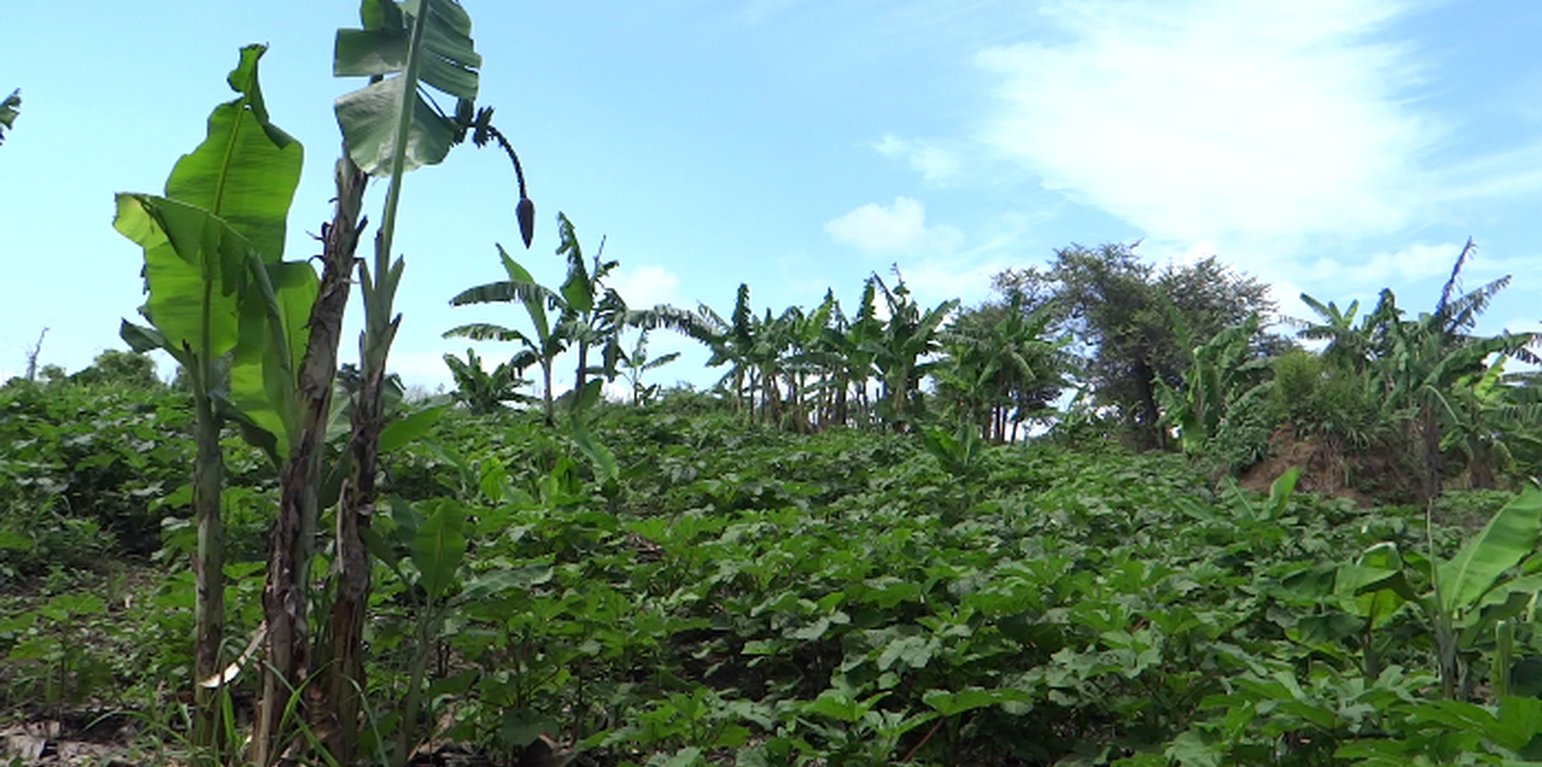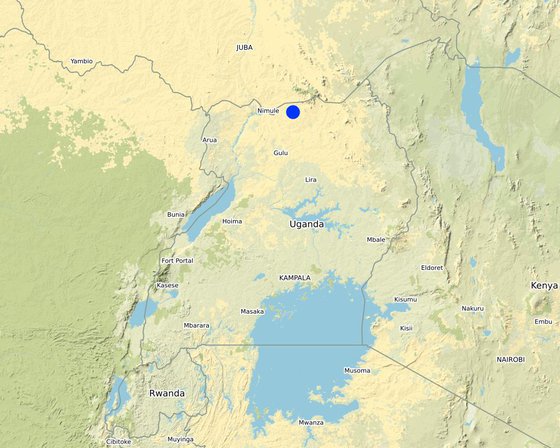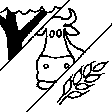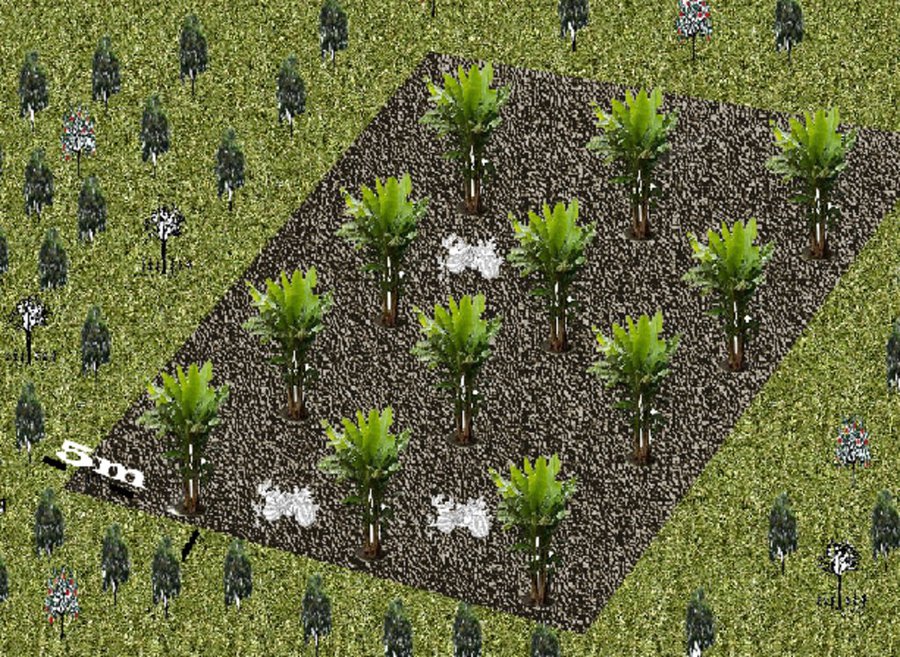



Strong dry winds in the plains of northern Uganda can be a serious challenge during dry periods, destroying perennial crops and farm structures. To overcome this challenge, farmers maintain blocks of natural vegetation around their plantations. In the case of this technology, the farmer has maintained natural vegetation around his banana plantation. Within the plantation there are other crops such as vegetables. The trees in the natural vegetation provide shade to the crops and act as wind breaks to the banana plantation.
The size of the plantation is approximately 2 acres. On either side of the plantation is a strip of natural vegetation with a variety of trees species but mainly drought-tolerant species such as Cobretum molle, Albizia coriaria and Accia seyal. Under these trees are grasses which are some times used for livestock. The distance between the banana plantation and the natural woodland is approximately 3 meters and the natural vegetation is approximately 5 meters wide. During the dry season the tall grass from the natural vegetation, if not used for livestock, is harvested and used as mulch in the banana plantation. This also serves to reduce the fire hazard that may spread from the natural vegetation into the plantations. It is also from the farmer's natural vegetation that sometimes poles are cut and used to support heavy bunches of growing bananas.
Generally, the technology does not require a lot of inputs, since bananas are a perennial crop requiring no regular purchase of seeds/seedlings. The major inputs that require regular supply are grass mulch and manure. The farmer usually gets the grass mulch from the natural woodland next to the bananas. He obtains the manure from either of his five cows in the Kraal or purchases additional animal manure from neighbors. On average the farmer adds three tons of manure each year and about a ton of mulch per year. The advantage is that mulch also decomposes easily and adds to the soil carbon and therefore the fertility of the soil. The labor for the work in the plantation is mainly household-based.
To be able to maintain his technology, the farmers need to have adequate labor to maintain a clear separation between the banana plantation and the natural woodland. The farmers also requires labor to manage the grass in the natural woodland so that it does not out grow to pose a fire risk and provide habitat for other dangerous animals like snakes and rodents.
This technology is suitable in areas where grazing is not a major farming activity because livestock can easily cross from the woodland into the banana plantation and destroy it in a very short time.

สถานที่: Pabbo Sub-county, Amuru District, Northern Uganda, Northern Region,Uganda, ยูกันดา
ตำนวนการวิเคราะห์เทคโนโลยี: พื้นที่เดี่ยว
การเผยแพร่ของเทคโนโลยี: กระจายไปอย่างสม่ำเสมอในพื้นที่ (approx. < 0.1 ตร.กม.(10 เฮกตาร์))
วันที่ในการดำเนินการ: 2009
ประเภทของการแนะนำ








| ปัจจัยนำเข้า | หน่วย | ปริมาณ | ค่าใช้จ่ายต่อหน่วย (Uganda Shillings) | ค่าใช้จ่ายทั้งหมดต่อปัจจัยนำเข้า (Uganda Shillings) | %ของค่าใช้จ่ายที่ก่อให้เกิดขึ้นโดยผู้ใช้ที่ดิน |
| แรงงาน | |||||
| Slashing | Days | 60.0 | 5000.0 | 300000.0 | 100.0 |
| Manure application | Days | 20.0 | 5000.0 | 100000.0 | 100.0 |
| Mulching | Days | 20.0 | 5000.0 | 100000.0 | 100.0 |
| วัสดุด้านพืช | |||||
| Dry grass | Ton | 1.0 | 100000.0 | 100000.0 | 100.0 |
| ปุ๋ยและสารฆ่า/ยับยั้งการเจริญเติบโตของสิ่งมีชีวิต (ไบโอไซด์) | |||||
| Animal manure | Ton | 2.0 | 150000.0 | 300000.0 | 100.0 |
| ค่าใช้จ่ายทั้งหมดของการจัดตั้งเทคโนโลยี | 900'000.0 | ||||
| ปัจจัยนำเข้า | หน่วย | ปริมาณ | ค่าใช้จ่ายต่อหน่วย (Uganda Shillings) | ค่าใช้จ่ายทั้งหมดต่อปัจจัยนำเข้า (Uganda Shillings) | %ของค่าใช้จ่ายที่ก่อให้เกิดขึ้นโดยผู้ใช้ที่ดิน |
| แรงงาน | |||||
| Slashing | Days | 60.0 | 5000.0 | 300000.0 | 100.0 |
| Manure application | Days | 20.0 | 5000.0 | 100000.0 | 100.0 |
| Mulching | Days | 20.0 | 5000.0 | 100000.0 | 100.0 |
| วัสดุด้านพืช | |||||
| Dry grass | Ton | 1.0 | 100000.0 | 100000.0 | 100.0 |
| ปุ๋ยและสารฆ่า/ยับยั้งการเจริญเติบโตของสิ่งมีชีวิต (ไบโอไซด์) | |||||
| Manure | Ton | 2.0 | 150000.0 | 300000.0 | 100.0 |
| ค่าใช้จ่ายทั้งหมดของการบำรุงรักษาสภาพเทคโนโลยี | 900'000.0 | ||||
Improved crop yields since effects of crops fall are reduced
Easy to manage field. Surrounding trees provide stakes for bananas
More yield brings about more income the farmer
Grass provides additional mulch cover to the soil surface
Tree leaves and mulch decompose to replenish the nutrients lost
Tree leaves and mulch decompose to provide humus
More diverse vegetation types on the land
Since grasses are cut and applied as mulch, fire does not easily spread in to the area
Trees act as wind breaks to reduce wind speed
The combination of trees, grass and bananas creates a conducive micro climate for biodiversity survival